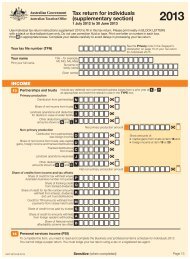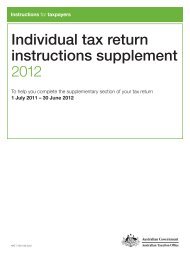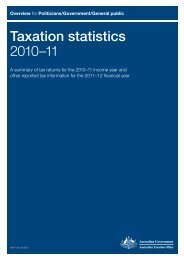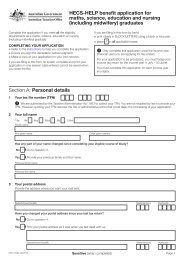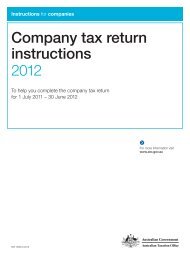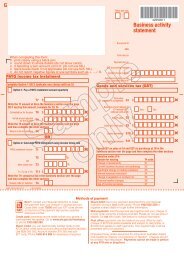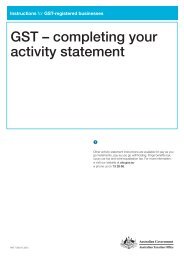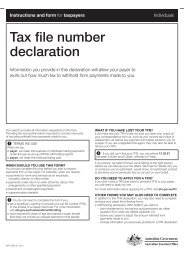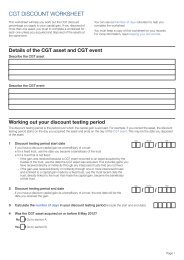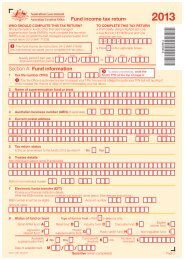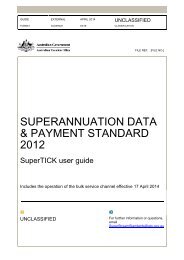Guide to depreciating assets 2013 - Australian Taxation Office
Guide to depreciating assets 2013 - Australian Taxation Office
Guide to depreciating assets 2013 - Australian Taxation Office
Create successful ePaper yourself
Turn your PDF publications into a flip-book with our unique Google optimized e-Paper software.
If you do not meet these requirements you can elect <strong>to</strong> havethe TOFA rules apply <strong>to</strong> you.TOFA rules and UCAThe TOFA rules contain interaction provisions which maymodify the cost and termination value of a <strong>depreciating</strong> assetacquired by an entity <strong>to</strong> which the TOFA rules apply. This willbe the case where payment (or a substantial proportion of thepayment) is deferred for more than 12 months after delivery ofthe <strong>depreciating</strong> asset.For more information seen TOFA and the cost of a <strong>depreciating</strong> asset (on page 17)n TOFA and the termination value of a <strong>depreciating</strong> asset(on page 19), orn <strong>Guide</strong> <strong>to</strong> the taxation of financial arrangements (TOFA)rules at a<strong>to</strong>.gov.au/<strong>to</strong>faTHE COST OF A DEPRECIATING ASSETTo work out the decline in value of a <strong>depreciating</strong> asset,you need <strong>to</strong> know its cost.Under the UCA, the cost of a <strong>depreciating</strong> asset hastwo elements.The first element of cost is, generally, amounts you are taken<strong>to</strong> have paid <strong>to</strong> hold the asset, such as the purchase price.It also includes amounts incurred after 30 June 2005 thatyou are taken <strong>to</strong> have paid for starting <strong>to</strong> hold the asset. Theamounts must be directly connected with holding the asset.The first element of cost is worked out as at the time youbegin <strong>to</strong> hold the asset.The second element of cost is, generally, amounts youare taken <strong>to</strong> have paid after that time <strong>to</strong> bring the asset<strong>to</strong> its present condition and location, such as a cost ofimproving the asset. It also includes expenses incurred after30 June 2005 for a balancing adjustment event occurring forthe asset (that is, costs incurred <strong>to</strong> s<strong>to</strong>p holding or using theasset). See What happens if you no longer hold or use a<strong>depreciating</strong> asset? on page 17 for information on balancingadjustment events. Such expenses may include advertising orcommission expenses or the cost of demolishing the asset.The first element of a <strong>depreciating</strong> asset’s cost cannot includean amount that forms part of the second element of cost ofanother <strong>depreciating</strong> asset. For example, if a <strong>depreciating</strong>asset is demolished so another <strong>depreciating</strong> asset can beinstalled on the same site, the demolition costs will form par<strong>to</strong>f the second element of cost of the asset demolished. Theamount is not also included in the first element of cost of thenew asset.In this guide, when the words ‘ignoring any GST impact’ areused it should be noted that if you are not entitled <strong>to</strong> claim aninput tax credit for GST for a <strong>depreciating</strong> asset that you hold,the cost of the <strong>depreciating</strong> asset includes any GST paid.EXAMPLE: First and second elements of cost,ignoring any GST impactTerry wants <strong>to</strong> buy a vehicle for his business and the vehicleis not available in Australia. He locates a company in theUnited States from which he would be able <strong>to</strong> purchase thevehicle. He travels <strong>to</strong> the United States for the sole purposeof buying the vehicle and incurs travel costs of $5,000.Terry purchases the vehicle for $45,000.The first element of cost is $50,000. This amount includesthe purchase cost of the vehicle and the travel costs. Thetravel costs would be included in the first element of cost ofthe vehicle because they are directly connected with Terrystarting <strong>to</strong> hold the vehicle. If Terry installs an alarm in thevehicle two months later at a cost of $1,500, that amountwill be included in the second element of cost of the vehicleas the cost was incurred after he began <strong>to</strong> hold the vehicle.For both first and second elements of cost of a <strong>depreciating</strong>asset, amounts you are taken <strong>to</strong> have paid include:n an amount you payn the market value of a non-cash benefit you providen if you incur or increase a liability <strong>to</strong> pay an amount,the amount of the liability or increasen if you incur or increase a liability <strong>to</strong> provide a non-cashbenefit, the market value of the non-cash benefit or theincreasen if all or part of another’s liability <strong>to</strong> pay you an amount isterminated, the amount of the liability or part terminatedn if all or part of another’s liability <strong>to</strong> provide a non-cash benefit(except the <strong>depreciating</strong> asset) <strong>to</strong> you is terminated, themarket value of the non-cash benefit or part terminated.The cost of a <strong>depreciating</strong> asset does not include:n amounts of input tax credits <strong>to</strong> which you are or becomeentitled; see GST input tax credits on the next pagen expenditure not of a capital nature, orn any amount that you can deduct or that is taken in<strong>to</strong>account in working out a deductible amount underprovisions outside the UCA.EXAMPLE: Expenditure not of a capital natureand deductible outside the UCACarolyn uses a mo<strong>to</strong>r vehicle for her business. As a result ofCarolyn’s use of the vehicle, she needs <strong>to</strong> replace the tyres.The cost of replacing the tyres is not included in the secondelement of the vehicle’s cost because it would ordinarily bedeductible under the repair provisions.There are special rules <strong>to</strong> work out the cost of <strong>depreciating</strong><strong>assets</strong> in certain circumstances. Some of the commoncases are covered below. If you are not sure of the cos<strong>to</strong>f a <strong>depreciating</strong> asset, contact us or your recognisedtax adviser.14 a<strong>to</strong>.gov.au GUIDE TO DEPRECIATING ASSETS <strong>2013</strong>



